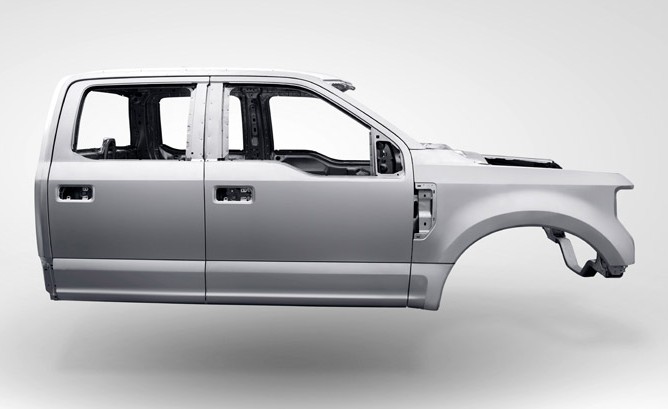Car panels, the outer skin of your vehicle, are susceptible to damage from minor dents to significant collision impacts. Understanding how to repair car panels is valuable knowledge for any car owner, whether you’re tackling a small DIY fix or understanding the process when you need professional help. While steel was traditionally used, modern vehicles increasingly utilize aluminum for its lightweight properties that enhance fuel efficiency. However, repairing aluminum car panels presents unique challenges compared to steel. This guide will walk you through the essentials of car panel repair, focusing on the nuances of aluminum and the general principles applicable to all car panel materials.
 Professional technician expertly repairs an aluminum car panel using specialized tools at Cline Collision Center, highlighting the complexities of modern auto body repair.
Professional technician expertly repairs an aluminum car panel using specialized tools at Cline Collision Center, highlighting the complexities of modern auto body repair.
Understanding Aluminum vs. Steel Car Panels
The rise of aluminum in auto manufacturing is driven by the quest for better fuel economy. Lighter cars consume less fuel, and aluminum panels contribute significantly to reducing vehicle weight. However, aluminum behaves differently from steel when it comes to repairs. A key difference is “work hardening.” When steel is reshaped, it tends to revert to its original form, possessing a sort of “memory.” Aluminum, on the other hand, once reshaped, takes on a new “memory.” The process of stamping aluminum into shape at the factory actually strengthens it. Similarly, bending aluminum in a collision also increases its strength, making it more prone to cracking if over-flexed, much like bending a spoon repeatedly.
Steps in Aluminum Car Panel Repair
Repairing aluminum car panels requires a careful and precise approach. Unlike steel, aluminum needs to be heated to allow for reshaping without causing further damage.
Heating Aluminum Panels
To effectively repair and pull out dents in an aluminum panel, it typically needs to be heated to around 400°F (204°C). This softens the metal, making it pliable enough to reshape. However, temperature control is crucial. Aluminum dissipates heat rapidly, but overheating is a serious risk. Exceeding approximately 750°F (399°C) can permanently alter the structural integrity of the aluminum, a process known as annealing, which weakens the panel. Technicians often use digital temperature-controlled heat guns to ensure precise heating. Due to aluminum’s high thermal conductivity, heat spreads quickly across the panel, sometimes requiring a second technician to heat the area while another uses dent pulling tools to reshape the panel simultaneously.
Removing Oxidation
Another critical factor in aluminum repair is addressing aluminum oxide. When aluminum is exposed to air, a thin layer of aluminum oxide forms rapidly, sometimes in as little as 15 minutes. This oxide layer has a significantly higher melting point (3,700°F or 2038°C) than the underlying aluminum (1,200°F or 649°C). This oxide layer prevents proper adhesion if you’re using techniques like stud welding for dent pulling. Therefore, removing this oxide layer is essential before any repair work. This is typically done using specialized tools such as stainless steel brushes and abrasive grinding discs designed for aluminum to avoid contamination. Inline removal tools can also aid in preparing the surface for repair.
Tools for Car Panel Repair
Specific tools are necessary for working with aluminum car panels. These include:
- Abrasive Grinding Discs: For removing paint and coatings.
- Inline Removal Tool: For surface preparation.
- Stainless-Steel Brushes: Specifically for removing aluminum oxide without contaminating the metal.
- Digital Temperature Set Heat Gun: For controlled heating of the aluminum panel.
- Dent Pulling Tools: Various tools designed for pulling dents, often used in conjunction with heating.
Conclusion: Professional Car Panel Repair
Repairing car panels, especially those made of aluminum, is a complex process requiring specialized knowledge, tools, and techniques. While understanding the basics of how to repair car panels can empower car owners, entrusting repairs to certified professionals like Cline Collision Center ensures the job is done correctly, maintaining the structural integrity and safety of your vehicle. Their expertise in handling different types of aluminum and utilizing the correct repair procedures guarantees a high-quality and lasting repair.
